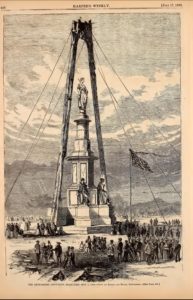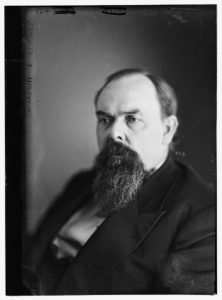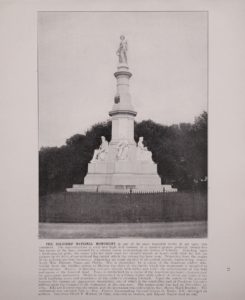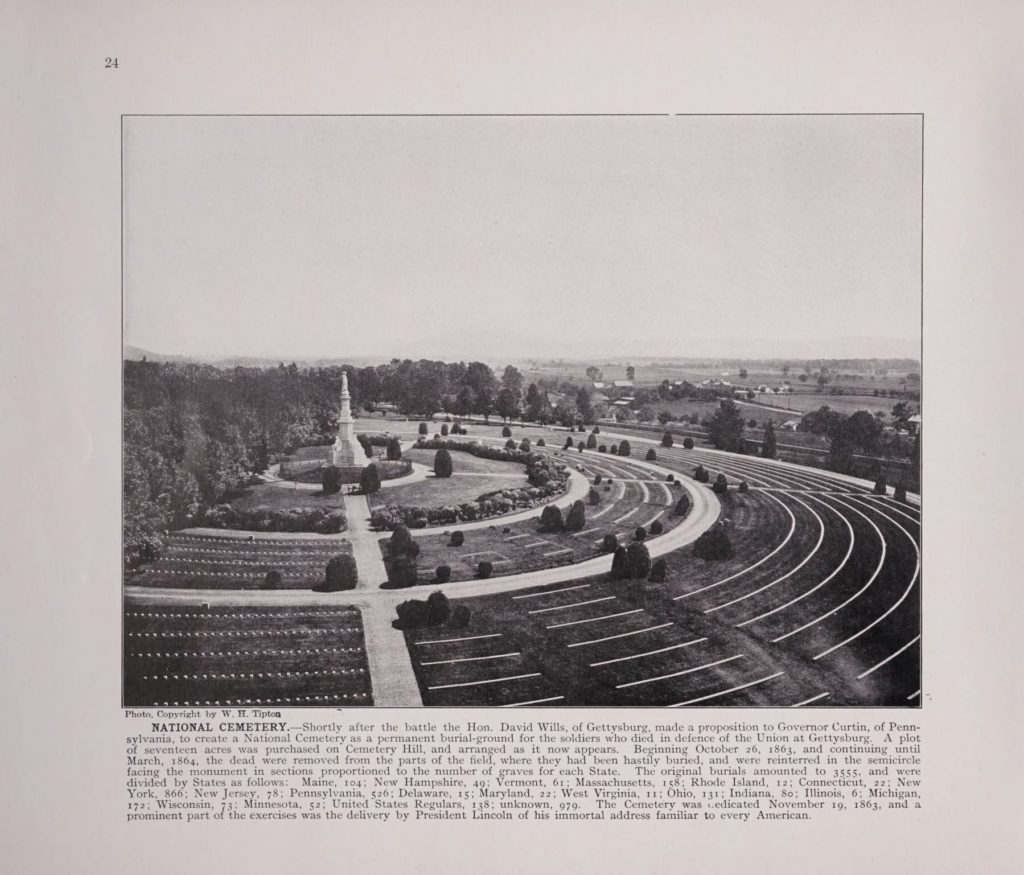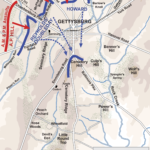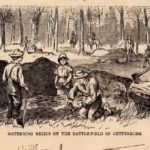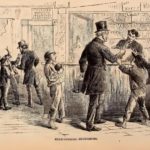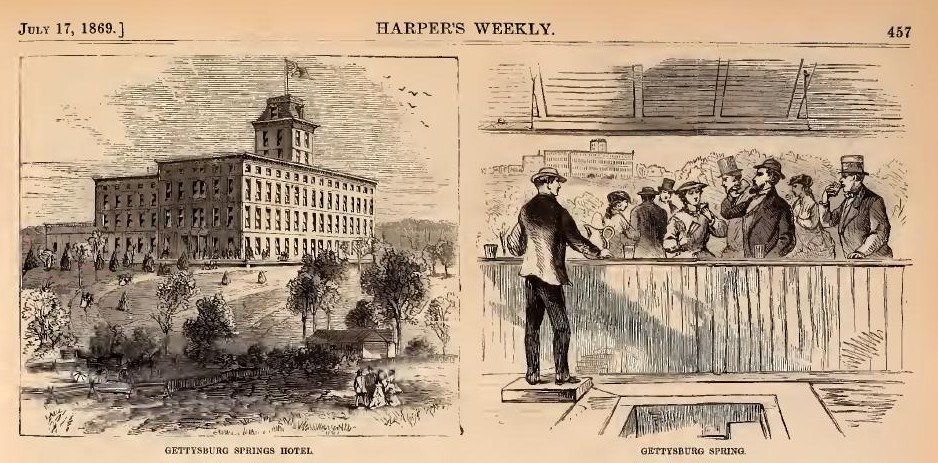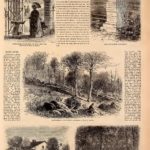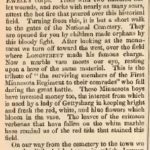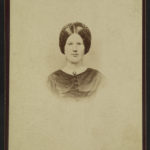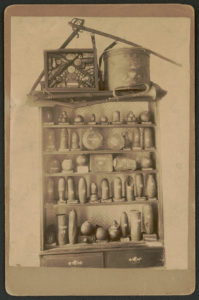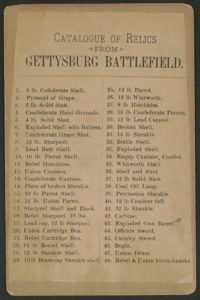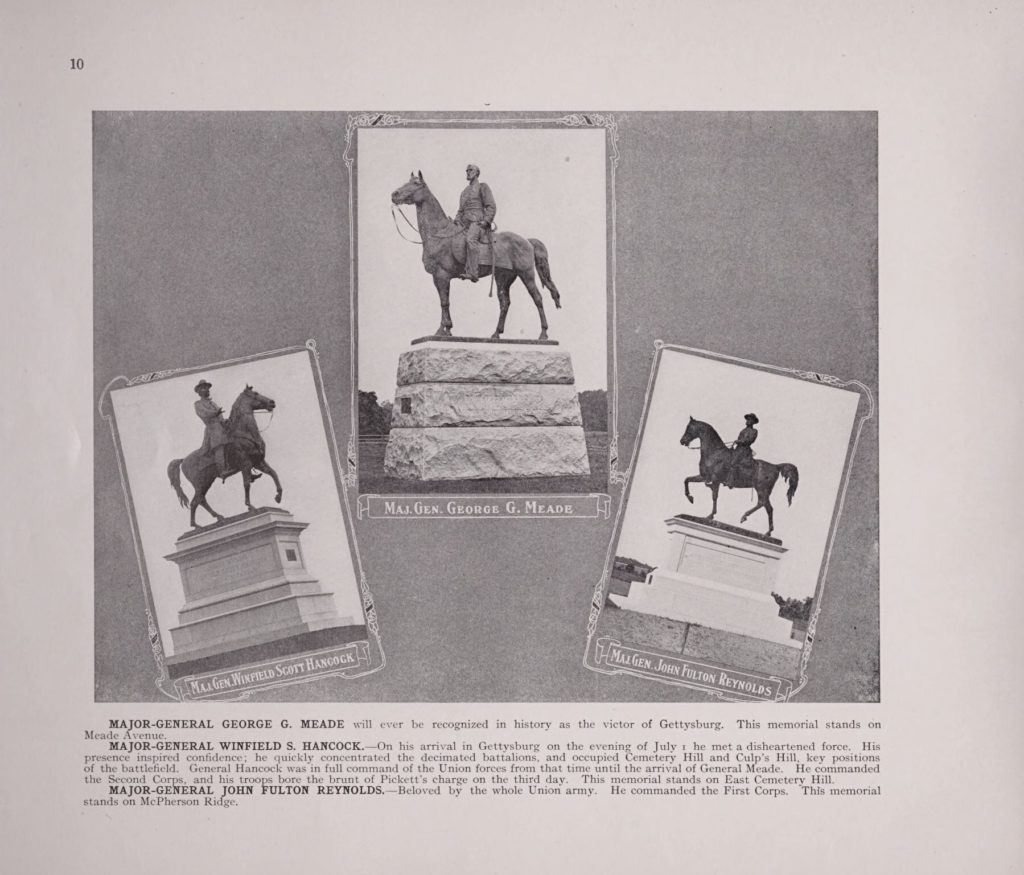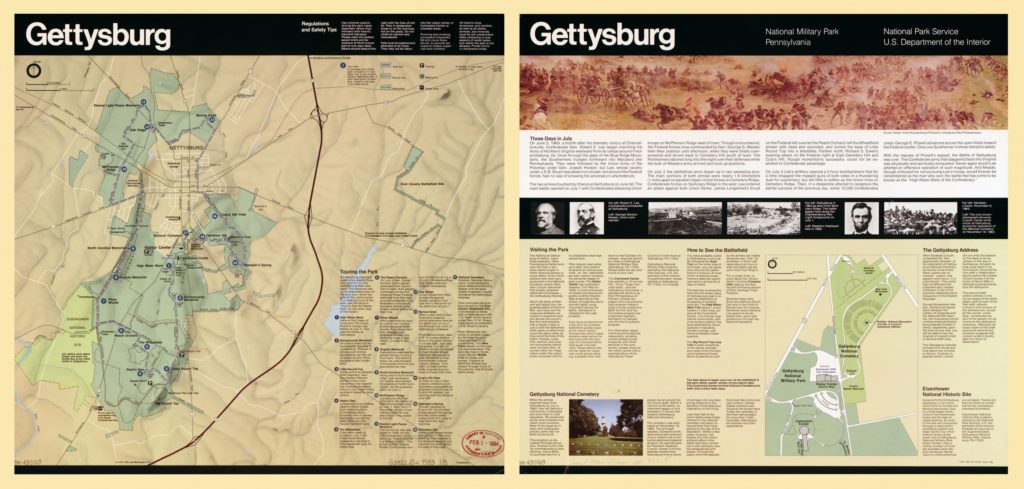On the sixth anniversary of Day 1 of the Battle of Gettysburg a monument in the National Cemetery on the battlefield was dedicated. The Soldiers’ National Monument hadn’t been quite completed, but a reported 15,000 people showed up for the ceremony. A United States Senator from Indiana, Oliver P. Morton, delivered the main address. A weekly newspaper quoted about three paragraphs of his lengthy speech: the surrender of Vicksburg on the day after Gettysburg was devastating to the Confederacy; the rebels might have lost their cause because of character defects; both the Northern and Southern soldiers were brave, and the dead are mourned both sides of Mason-Dixon. The article included the last paragraph of the Gettysburg Address, which inspired the first stanza of a poem written and recited for the occasion. Next the newspaper quoted from a travel magazine’s piece about Gettysburg. The journalist apparently got involved a little bit in what had become an important business for the town.
From the July 17, 1869 issue of Harper’s Weekly:
THE GETTYSBURG MONUMENT.
On the 1st of July the Monument erected by the loyal States to the memory of those who perished on the battlefield of Gettysburg was formally dedicated. It is erected in the cemetery in which the soldiers were buried where they fell. Fifteen thousand people were present at this dedication.
The Rev. HENRY WARD BEECHER made the opening prayer. General MEADE made an appropriate speech, recalling the history of the battle. An address was read by Senator O.P. MORTON. He gave an eloquent review of the progress which Freedom has made during the last decade on both continents. He spoke of that 4th of July, 1863, as the most memorable since 1776. It was not only a day of victory in the East. “On another field it witnessed the surrender of another large rebel army to the great chieftain of the war, now our illustrious President. The captured of Vicksburg opened the navigation of the Mississippi River, and severed from the Confederacy all that part of its territory lying west of that river. The loss to the Confederacy was irreparable. It was cut off from its chief source of supplies. The limits of the war were greatly circumscribed. The mass of the rebel population was demoralized, and began to despair. From that day it became manifest that the rebellion could not succeed unless the Southern people exhibited that endurance, patience under adversity, and high devotion that will sacrifice every thing for the cause, which, as it turned out, they did not possess. By our victories at Gettysburg and Vicksburg the rebellion lost its prestige in Europe and all hopes of foreign intervention.”
“At the foot of this Monument,” he continued, “sleep the heroes of the battle. Here lie the father, the husband, the brother and the only son. In far off homes, among the hills of New England, on the shores of the lakes and in the valleys and plains of the West, the widow, the orphan, and the aged parent are weeping for these beloved dead. Many of the tombs are marked “unknown,” but they will all be recognized on the morning of the resurrection. The unknown dead left behind them kindred, friends, and breaking hearts. None die so humble but leave some one to mourn. ‘Perished at Gettysburg, in defense of their country,’ 979 men, of whose names, homes, or lineage, there is no trace left on earth. Doubtless the Recording Angel has preserved the record, and when the books are opened on the last day their names will be found in letters of living light, on the immortal page of heroes who died that their country might live.
“In the fields before us are the graves of the rebel dead, now sunk to the level of the plain, ‘unmarked, unhonored, and unknown.’ They were our countrymen, of our blood, language, and history. They displayed a courage worthy of their country and of a better cause, and we may drop a tear to their memory. The news of this fatal field carried agony to thousands of Southern homes, and the wail of despair was heard in the everglades and orange groves of the South. Would to God that these men had died for their country, and not in fratricidal strife for its destruction. Oh, who can describe the wickedness of rebellion, or paint the horrors of civil war!”
The monument is sixty feet in height. It consists of a massive pedestal twenty-five feet square at the base, crowned with a colossal statue representing the Genius of Liberty. Standing upon a three-quarters globe, she holds in her right hand the victor’s wreath of laurel, while with her left hand she clasps the sheathed sword through whose uncovered power the victory was won. Projecting from the angles of the pedestal are four buttresses supporting an equal number of allegorical statues, representing respectively War, History, Peace, and Plenty. War is personified by a statue of the American soldier, who, resting from the conflict, relates to History the story of the battle, which the monument is intended to commemorate. History, in a listening attitude, records, with stylus and tablet, the achievement of the field and the names of the honored dead. Peace is symbolized by a statue of the American mechanic characterized by appropriate accessories. Plenty is represented by a female figure with a sheaf of wheat and fruits of the earth, typifying peace and abundance as the soldier’s crowning triumph. The monument was designed by JAMES G. BATTERSON, of Hartford, Connecticut. The statues are of Carrara marble, and were executed in Italy.
It is impossible, in connection with this dedication, to forget the 19th of November, 1863, when President LINCOLN, standing upon the battle-field, delivered that short but memorable address, which will forever be associated with the greatest victory of the war. “In a larger sense,” he said, “we can not dedicate, we can not consecrate, we can not hallow this ground. The brave men, living and dead, who struggled here have consecrated it, far above our power to add or detract. The world will little note nor long remember what we say here, but it can never forget what they did here. It is for us, the living, rather, to be dedicated here to the unfinished work which they who fought here have thus far so nobly advanced. It is rather for us to be here dedicated to the great task remaining before us, that from these honored dead we take increased devotion to that cause for which they here gave the last full measure of devotion; that we here highly resolve that these dead shall not have died in vain; that this nation shall, under God, have a new birth of freedom; and that government of the people, by the people and for the people, shall not perish from the earth.”
BAYARD TAYLOR, in the opening passage of his poem repeated by him on the occasion of the dedication, beautifully alludes to this address:
After the eyes that looked, the lips that spake
Here, from the shadows of impending death,
Those words of solemn breath,
What voice may fitly break
The silence, doubly hallowed, left by him!
We can but bow the head, with eyes grown dim.
And, as a Nation’s litany, repeat
The phrase his martyrdom hath made complete,
Noble as then, but now more sadly sweet:
“Let us, the Living, rather dedicate
Ourselves to the unfinished work, which they
Thus far advanced so nobly on its way,
And save the periled State!
Let us, upon this field where they, the brave,
Their last full measure of devotion gave,
Highly resolve they have not died in vain!
That, under God, the Nation’s later birth
Of Freedom, and the People’s gain
Of their own Sovereignty, shall never wane
And perish from the circle of the earth!”
From such a perfect text, shall Song aspire
To light its faded fire, –
And into wandering music turn
Its virtue, simple, sorrowful, and stern!
His voice all elegies anticipated:
For, whatsoe’er the strain,
We hear that one refrain,
“We consecrate ourselves to them, the Consecrated!”
THE BATTLE-FIELD.
A correspondent of the Boston Traveller has recently visited the battle-field of Gettysburg, and writes as follows:
On Seminary Ridge the trees and fences are shattered and riddled, showing plainly how fierce was the contest where the fight began. Here we found two bullets, one driven into the other so far that they could not be pulled apart. The supposition is that a Union and a rebel sharp-shooter aimed so accurately for each other, and fired at so near the same time, that the bullets met, and one being a little more dense than the other, pierced the one coming from the opposite direction. Both fell, of course, to the ground, and thus prevented the death of both the marksmen, which must have been the result had the bullets merely grazed each other.
When we spoke of this curiosity at the hotel a whole army of relic speculators wished to purchase it. Doubtless the sum which we received for it was trebled when sold to the memento seekers who frequent the town. These speculators do a thriving business in the relic line, and have every thing to sell from a 100-pound shell to the smallest wares of the toy-shop, all in some way connected with the battle.
Canes cut from Culp’s Hill or Little Round Top are for sale in many shop-windows, and if the purchaser is a little incredulous and inclined to doubt that the canes came from those places, they will march out with him, take any sapling he may select, and make it into a cane in a remarkably short space of time. This business has become one of great importance to Gettysburg, and it is proposed to introduce machinery for the manufacture of toys from the battle-field wood.
The traces which we found of the fight along the front of Hancock’s and Sedgwick’s line – except in the blasted peach orchard – were not very distinct, owing to the growing fields of grain and the repairs which have been put upon the few farm-houses. But the graves of the rebel dead are there, dotting the fields for miles around. In one or two places the bones were sticking out, but generally their graves were covered with clover, and had none of that barbarously neglected appearance they have in the South.
At Little Round Top the bullet scars are still visible on the rocks, while several large flat stones near which officers were killed have been engraved with their names and and the date of their death. The stone-wall which the troops threw up as a breast-work is still entire, and the trees have not yet outgrown their wounds.
Our illustrations on pages 456 and 457 are mainly from sketches by THEODORE R. DAVIS.
One of our pictures represents the Gettysburg Spring. The curative properties of the spring were first brought prominently into notice in connection with the battle. The rebels were encamped about it, and their sick drank of its water and experienced relief. Adjoining the illustration of the spring we give another representing the Gettysburg Springs Hotel. This hotel is situated on the battle-field, one and one-half miles west of Gettysburg, near the spot where General REYNOLDS fell. This hotel has been built since the middle of February last, by a company composed of the members of the Gettysburg Springs Company and the most prominent citizens of the town. It is in every respect commodious, well appointed, and furnished with all the modern improvements. The scenery about it is of unrivaled beauty.
Harper’s Weekly returned to Gettysburg in its next issue, providing more information about the army of urchins selling battlefield relics, Culp’s Hill, the spot where General John F. Reynolds was killed, and Jennie Wade, the only civilian killed during the three day battle on July 3rd.
______________

